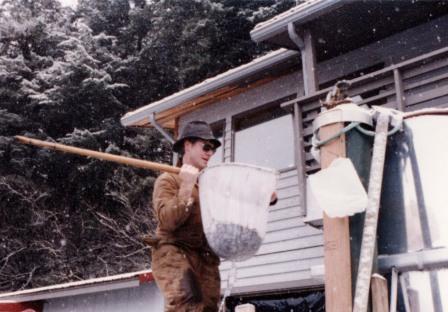The visionary behind Douglas Island Pink and Chum, Inc. is a man by the name of Ladd Macaulay. He was born in Seattle, Washington in 1942 to a family of Scottish descent. The family moved to Juneau, Alaska in 1956 where his father worked as an electrical engineer for the local power company. Ladd graduated from Juneau Douglas High School and the University of Montana with a degree in biology and a teaching certificate. In 1966, he returned to Juneau to begin teaching biology in the new Marie Drake Junior-High School. During the 1970’s he began an environmental education program that included an outdoor-education camp for 6th grade students, Sea Week, emergency and outdoor survival classes and an immigration education program for students to experience the imaginary life of the Yukon Gold Rush of 1898. In 1975, Ladd left teaching and later became employed by the State of Alaska as a loan officer for the Division of Investments in the Department of Commerce. Ladd began to develop the idea of building a hatchery in the Juneau area in the early 70’s spending many hours visiting hatcheries, studying at the library, attending public meetings, and other activities to learn about the steps needed to set-up a private non-profit hatchery. Through his initiative, experience, and fish culturist training with the F.R.E.D. division of Fish and Game, Ladd became a self-educated fish culturist.
In 1974 salmon runs reached a record low, and the State of Alaska enacted legislation allowing private non-profit hatcheries to "partner" with the state to enhance salmon resources. In 1975 the State established a revolving loan fund through the Department of Commerce and Economic Development; specifically for providing grants and loans for hatchery planning, construction, operation, and implementation of fisheries enhancement and rehabilitation activities. Back in 1975, a commercial Troller, Norman Morris literally laid $500 cash on the table and told Ladd to "get this thing moving." All members of the soon-to-be "DIPAC" corporation thereafter had to give $500 as Norman did, with no expectation of ever receiving a return on the original investment. Ladd turned his vision for salmon enhancement into the original DIPAC hatchery located in the back yard of his family home on Kowee Creek. After having incubated salmon eggs on the back porch the first year, the permanent incubation facility became located in one of Joe Juneau's old mining shafts the following year. It was not until 1977 that pink and chum eggs were taken from Fish Creek, located ten miles north of the Kowee Creek hatchery on Douglas Island, by volunteers using a beach seine. Egg-take and fertilization was done on site at the Fish Creek. The following Spring, the salmon fry were moved to DIPAC's first fish pond - a children's swimming pool purchased from Sears, and by 1979, 20-30,000 pink salmon salmon returned to the Kowee Creek Hatchery. This stream had not seen one salmon in the previous seven years.
It was with the successful return of pink salmon at Kowee Creek that Ladd left state employment and began to expand DIPAC with the building of a second hatchery at Sheep Creek, south of Juneau on Thane road. This 2 million dollar hatchery launched DIPAC from a "mom and pop" organization to a major salmon producer for Northern Southeast Alaska. In response to the city of Juneau's efforts to diversify its economy, Ladd proposed plans in 1985 for the Gastineau Salmon Hatchery (renamed in 2000 to Macaulay Salmon Hatchery) that would use water from the Alaska Electric Light and Power Company's Salmon Creek Hydro-Electric Dam. In 1987, construction began on the Macaulay facility while the first salmon were being reared and released from the net pens at the Gastineau site. The Macaulay Hatchery was completed in June of 1989 at a capital cost of 7.4 million dollars (nearly the same cost as the purchase of Alaska from Russia). In July, the first returning hatchery salmon began to enter the fish ladder into the broodstock holding area. As a result of Ladd's dedication to education, a visitor center was also included in the plans for the Macaulay Salmon Hatchery. It was built to provide a place for adults and children to learn about salmon, their near-shore marine environment, hatcheries, and the Alaska commercial fishing industry.
Ladd retired from the position of Executive Director at DIPAC in 1997, as well as from the Board of Directors. He returned to state service at the Department of Commerce and Economic Development, picking up where he left off to start DIPAC over 20 years ago. Ladd was tragically killed by a drunk driver in a car crash on April 19, 2000 while on state business visiting hatcheries in south-central Alaska. Ladd will be sorely missed, but his legacy will live on through DIPAC. Douglas Island Pink and Chum, Inc. remains a shining example of how one man’s dream can become a major influence on the state of Alaska’s fishing industry, economy, and way of life.




